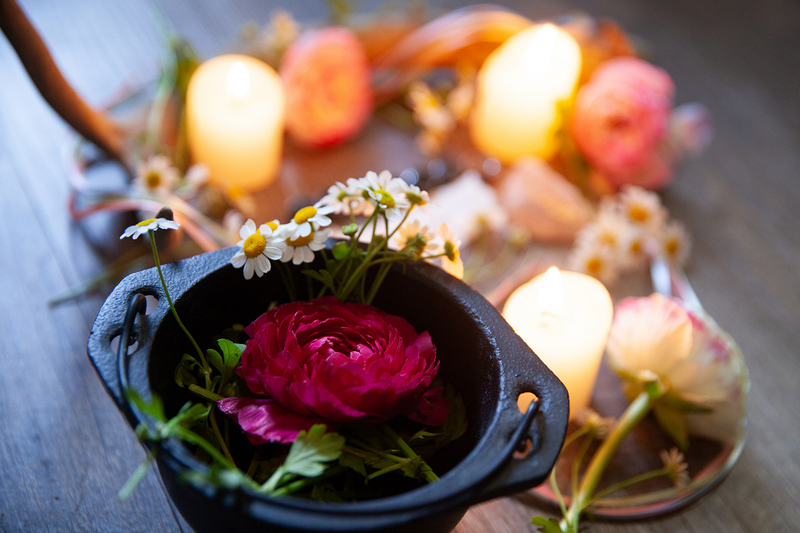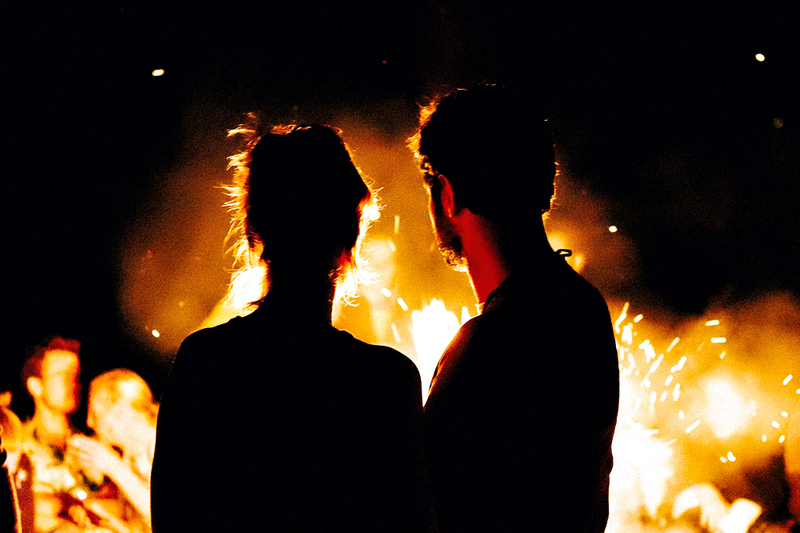AMERICAN WEDDINGS BLOG
Stay up to date with the latest wedding ceremony trends, script writing inspiration, tips and advice for first-time officiants, and news that matters to couples and wedding ministers.
Stay up to date with the latest wedding ceremony trends, script writing inspiration, tips and advice for first-time officiants, and news that matters to couples and wedding ministers.
Published Tuesday, May. 4th, 2021
Last updated Thursday, May. 23rd, 2024

Beltane is a time of abundance and passion, sexuality and fertility, new beginnings and high-energy romance. The word means ‘fires of Bel’ or ‘bright fires,’ and originally celebrated the Celtic god Bel (also known as Belenus), the Sun god.
Beginning on May Eve (April 30th) and lasting throughout the following day (May 1st), this fire festival arrives at the height of Spring’s dazzling display of vibrancy and life, and has been celebrated for centuries with feasts, laughter, and large communal bonfires.
It’s also a prime time for romance… In ancient eras, couples wandered the woods together picking flowers in the sunshine by day, and professed their love to each other around the fire at night …
These confessions of love led to countless engagements and marriages...a tradition that continues to this day!
Other stories associate Beltane and May Day (which falls on the same day) with other folktales of fertility and nature’s abundance, including the courtship of a God and Goddess, who reunite after a long winter apart to join in marriage. Depending on the specific tradition, these stories speak of Flora the Goddess of Spring, the May Queen, the May King, Jack in the Green, the Horned God of Greenwood, and the Green Man. Hundreds of years later, many people still reenact these tales as part of their Beltane and May Day celebrations!
Beltane weddings, handfastings, and engagement ceremonies are especially popular with Pagan couples. But the holiday's fiery energy is perfect for any couple or wedding officiant looking to infuse a spring wedding with passion and excitement.

Couples: Choose an outdoor venue where a bonfire or campfire is permitted. If this type of venue isn’t available, you can modify this outline to work with a fire bowl or candles.
If you’re using candles, visit this sample script for detailed inspiration: Pagan Handfasting Script with Fire, Flowers and Offerings.
You’ll need plenty of wood to burn, and stones or other markers to place in a circle around the ceremony space. Bring chairs and blankets for friends and family, or opt for a B.Y.O.S. (bring your own seating) approach. Just make sure to include clear instructions on your invitations if guests need to bring their own supplies.
Designate someone (or someones) as ‘fire tender.’ You’ll need someone to light the bonfire, keep it lit, and keep an eye on it for as long as your celebration lasts. Start the fire before the ceremony, and let friends and family mingle around it.
Choose a space close to the fire for you and your officiant to stand. This will be the space where you place your wedding altar, offerings, arch, or podium, if you choose to use one. Don’t stand so close to that you overheat or catch on fire, though...
Invite your loved ones to bring musical instruments to the event! Drums, flutes, guitars, saxophones -- everything works. Give them the opportunity to welcome you into marriage with a cacophony of joy befitting a fire festival!

Guests are seated in a loose circle around the ceremony space, with the officiant waiting inside the circle to begin the ceremony. The officiant might walk a circle around the ceremony space the day of the wedding, blessing it before the ritual begins.
Then, get creative with the walk down the aisle! Beltane rituals often include acting out a playful courtship, making it easy for couples to create a memorable, one-of-a-kind procession with the help of their wedding officiant.
Instead of walking up to the officiant in a straight line, add a little chase!
The couple will chase each other in a circle around the bonfire, weave between seated guests, and reenact the ‘pursuit’ of love! This should be joyful, playful, and fun, with obvious consent on both sides, so they’ll take turns with who chases who. Don’t forget to let guests in on the joke!
To make things go smoothly, this part should be planned carefully with the officiant. As a group, decide how long the ‘chase’ will last, and whether or not the officiant will use a signal or phrase to call the couple back to the altar when time’s up.
Once the couple is finally center stage, the officiant welcomes the guests and introduces the couple.
The officiant explains the purpose of the gathering (a marriage, betrothal, or commitment ceremony), and points out how meaningful it is that friends and family have gathered together to celebrate the prosperity of Spring, the start of a marriage, and the couple’s bright future. They’ll talk about the significance of Beltane and share a few details about the couple’s personal connection to the day.
If the couple is including any specific ancestors, spirits, gods, or goddesses in the ceremony, the officiant welcomes and calls to them by name.

The officiant asks each partner why they’ve come to the circle that day. This establishes in a sweet way that the partners are entering the marriage willingly and happily.
This can be as simple as the officiant saying:
“(Partner’s name), why are you here today?”
And each partner answering:
“I’m here to marry my beloved.”
Then, the officiant tells the guests that the couple have written personal vows (or poetry, or music), and faces each partner in turn.
Each partner shares their vows, taking the hand of the other, and then exchanges rings.
If the couple wants to include a handfasting ritual, this can be done during or right after the vow exchange. Handfasting rituals are incredibly versatile, so this can be approached any way the couple wants. It can be lighthearted, solemn, or anything in between.
If you want to add a handfasting, visit the sample script A Modern Wiccan Handfasting Format and Script and read How to Tie a Handfasting Cord -- The Infinity Knot for more inspiration.

The officiant mentions that historically, Beltane rituals blessed the fields and families of ancient Ireland and Scotland in hopes of bountiful harvests, healthy children, and a prosperous summer season. In the same way, marriages on Beltane are made with the hope of a full and successful future.
The officiant encourages guests to stand and shout out their blessings to the couple, or to make cheerful sounds on their instruments. This will be loud and unruly, but that’s the fun of it!
(Note: Any guests who are unable to stand should be seated with this in mind, so that they can remain included in the circle.)
If any ancestors, spirits, gods, or goddesses have been welcomed into the ceremony, the officiant will greet them again and ask for their blessings.
If the couple is making offerings to any of these spiritual guests, they’ll place their offerings in the fire now, while following their own personal practices.
As the clamoring quiets down (or when the officiant calls for everyone’s attention), the officiant declares the couple to be officially married (or engaged, committed, bound).
Cheers rise up from the crowd again and the couple kiss!
The officiant announces that the ceremony is over, thanks and bids farewell to any ancestors or spiritual guides that have been invited, and wishes all guests a day of joy and warmth. The couple leaves the circle while their friends and family cheer.
The wedding ceremony is followed by feasting and songs around the fire.

Ancient accounts of Beltane rituals describe townspeople walking cattle and livestock between the flames and smoke of two bonfires, as a way of purifying and magically protecting them from disease. This tradition continued in Ireland throughout the 1800s!
Other rituals and offerings to the gods would secure a successful crop, protecting the fields from blight, and the birth of many healthy children.
Depending on the region, Beltane is also spelled Beltine, Irish Beltaine or Belltaine, and is sometimes called Cétamain. The holiday was first recorded in text in the 800s by a man named Cormac, who was the bishop of Cashel and king of Munster.
Though usually celebrated on May 1st, some people prefer to celebrate the holiday on May 5th, calling it ‘Old Beltane.’ This date may be closer to the halfway point between the vernal equinox and summer solstice, an astrological cross quarter day, due to changes in the Earth’s position over time.
Become an ordained minister online with American Marriage Ministries -- it's quick, easy, and free.
An illustrated guide to handfasting
 Explore the origins of ancient Paganism and learn how to add the magic of handfasting into your own wedding or commitment ceremony.
Explore the origins of ancient Paganism and learn how to add the magic of handfasting into your own wedding or commitment ceremony.
This deep dive into one of the most exciting trends in weddings is inspired by love stories that reach far back into the misty origins of human history, when Druids and Priestesses dispensed esoteric wisdom, cast powerful spells, and magic and nature were one-and-the-same.
Written and illustrated by AMM’s own Jessica Levey, this book is full of whimsical illustrations, and carefully researched and crafted stories and imagery that are your ticket to your own adventure.
Become a Wedding Officiant with Our Free Online Ordination!